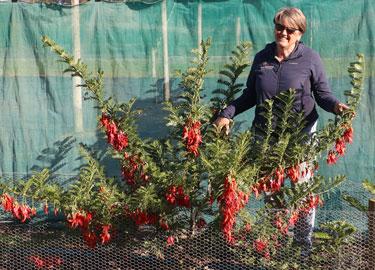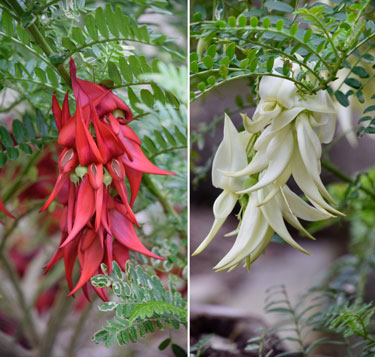Gardeners to the rescue
Instantly recognisable in spring when dressed to the nines in its dazzling scarlet parrot's beaks, ngutukākā, aka kākābeak, is much loved by kiwi gardeners. But not so many of us are aware that this national treasure is seriously threatened in the wild, why that matters, and how we can help.
There have been 255 springs since Captain Cook sailed into Anaura Bay on the East Coast. During their first arrival in Aotearoa, in October 1769, the crew of the Endeavour were so inspired by the beauty of ngutukākā that they collected seeds to take back to England. Others would soon follow suit and records show that NZ kakabeak was grown successfully in the UK since at least the early 1800s. Lately, seeds from the descendants of those early migrants have made it back to New Zealand.
But regrettably, since European settlement, East Coast’s once prolific ngutukākā has been pushed to the brink of extinction. By the early 1900s it was already noted as being uncommon in the wild. Its conservation status is now classified as ‘Nationally Critical’. Wild goats, deer, pigs, rabbits and hares find this tasty member of the pea-family extremely nutritious. Ngutukākā has no defence against these introduced browsers. Farm animals and snails find it irresistible too. On the upside, there is yet no evidence to suggest that possums have developed a taste for it, but introduced pest plants (such as gorse) pose further threat. As do cyclones, snow storms and drought.
Even though kākābeak is grown widely in gardens, there are only around 100 plants known in the wild. Why this matters comes down to survival of the fittest and the importance of biodiversity. Even if the numbers weren’t so critically low, a lack of genetic diversity puts a species at greater risk of extinction when things go wrong. For instance, if all the plants in a population are equally as vulnerable to an environmental threat, all may be wiped out before that species can adapt. The nursery-bred plants we currently have in our gardens are lacking in genetic diversity, and may have been subjected to selection for flowering or form, possibly at the expense of their survivability in the wild. And so promotion of wild sourced material for gardeners is seen as vital to make the genetics and the plants themselves stronger, for potential later release to wild habitat.
Wild ngutukākā survives on sunny steep sites, often on rocky outcrops (which are difficult for grazing animals to reach), slips, the bases of cliffs, and on the edges of lakes and streams. Presently, wild ngutukākā is growing on Moturemu Island in the Kaipara Harbour, at several locations on East Cape and in Hawke’s Bay. Over the years, it has also been reported in Northland, Auckland, Great Barrier Island, and Coromandel, possibly due to gifting between early Māori.
The Urban Kākābeak Project
Protecting the few wild plants that remain and establishing new populations in their natural habitat won’t be easy, but it’s a task being taken seriously by the Ngutukākā Recovery Group led by the Department of Conservation. The end goal is to re-establish ngutukākā in its natural habitat.
One of a number of rescue strategies by Ngutukākā Recovery Group members, is a new initiative in Hawke’s Bay where only a handful of wild ngutukākā remain. Funding for the Urban Kākābeak Project comes from a number of businesses and community organisations including Pan Pac Environmental Trust, Department of Conservation Community Fund, Plant Hawke’s Bay nursery, Ngati Pahauwera Development Trust, Biodiversity Hawke’s Bay, Forest Lifeforce Reforestation Trust, RedAxe Forestry Intelligence and Rockwell Automation. Hawke’s Bay Regional Council and Napier City Council are also engaged with the project.
“The Urban Kākābeak Project offers a way for gardeners to make a real difference,” says Marie Taylor of Plant Hawke’s Bay native plant nursery. “By establishing wild-sourced plants in the goat and deer free environment of urban gardens we can establish strongholds of the endangered ngutukākā genetics.”
“Each wild plant is named for the person who found it or its wild location. Progeny carry the parent’s names such as Helen, Pete, Vicky and Bluff. These progeny of wild plants then produce seeds and cuttings for propagation. So, even if we lose all the plants in a wild location, we can still save the genetic material that is critical to keeping the genetic diversity of ngutukākā intact.”
September and October, when the plants are heavily in bloom, are the best months to spot ngutukākā in the wild. If you live near a site where ngutukākā grows naturally, the Ngutukākā Recovery Group members are keen to talk to you. Call or email them to discuss the best options and how you can become involved in the recovery of this precious national treasure back into the wild. “Human intervention through introduction of animals, has risked the loss of this precious species, and it is human intervention that is the key to its future, it needs our help,” says James Powrie, leader of The Urban Kākābeak Project.
Join the Urban Kākābeak Project Group on Facebook or contact them by email at redaxenz@gmail.com.
DID YOU KNOW?
- Ngutukākā is found only in New Zealand, with its closest relative in Australia. New Zealand has two species, Clianthus puniceus and Clianthus maximus. Both are seriously threatened with extinction in the wild.
- ‘Ngutu’ means beak or lips and ‘kākā’ is the name of our colourful native parrot. Clianthus puniceus means “blood red flower of glory”.
- Though it is a relatively short-lived plant (15-20 years at best), ngutukākā produces very long lived seed. Seeds as old as 30 years may germinate. This means seeds can hibernate in the ground over the less favourable years, ready to germinate when conditions suit. It's a useful trait for a sun loving shrub that grows in bush that’s not permanently open but frequently disturbed, letting the light in.
- Reaching 2-3m tall, the shrub has long trailing branches that can take root and establish new plants when in contact with the soil.
- As a legume, ngutukākā can fix its own nitrogen, helping it to grow in poor, infertile ground.
- For centuries, Māori have treasured and cultivated ngutukākā for decoration, as a food source and for gifting and trading.
The white Ngutukaka
The rare white-flowered kakabeak was last seen flowering near Wairoa in the 1950s and considered extinct. But with the chance discovery of a bag of seeds taken from the Wairoa area, plants were raised by Scion in Rotorua. In 2015, 100 plants were returned to the area and planted on the ancestral lands of East Coast iwi Ngati Kohatu and Ngati Hinehika.
How to grow Kākābeak
- Plant in a sheltered location in part shade, not hot blazing sun or full shade.
- Control slugs and snails.
- Provide any surplus wild sourced seeds, preferably labelled by plant name amd location, to Urban Kakabeak Project 64 Waghorne St. Napier.

1-Mar-2025

Marie Taylor of Plant Hawke's Bay with one of the wild progeny

For the gardener, there is the red variety and the less common white kakabeak

